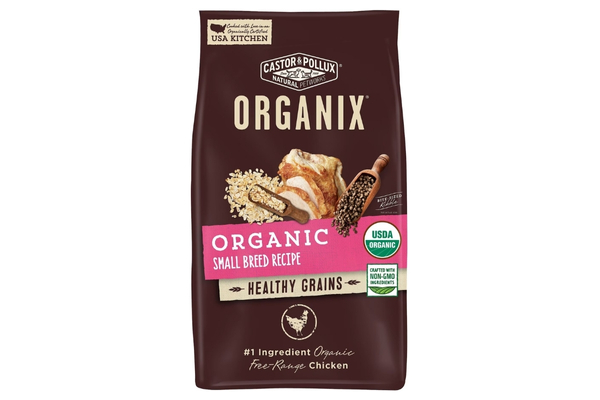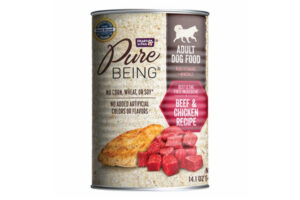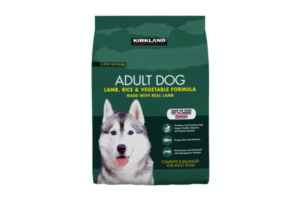When you’re standing in the pet store aisle surrounded by countless dog food options, Castor & Pollux might catch your eye with its organic certification and natural ingredient promises. But behind the wholesome marketing lies a more complex story of corporate acquisitions, price increases, and changing consumer trust. After spending considerable time analyzing this brand’s evolution from independent organic pioneer to corporate-owned premium line, I’ll give you the honest breakdown you need to make an informed decision.
What Castor & Pollux Represents Today
From Independent Pioneers to Corporate Ownership
Castor & Pollux started in 2000 with genuine passion for organic pet nutrition. Founders Shelley Gunton and Brian Connolly built something special in Clackamas, Oregon – they created the first USDA-certified organic dog food that met all National Organic Program requirements. For over a decade, they were the scrappy underdogs fighting for better pet nutrition standards.
Then came the acquisitions. First Merrick Pet Care bought them in 2012, consolidating operations in Texas. Three years later, Nestlé Purina swooped in and acquired Merrick, bringing Castor & Pollux under one of the world’s largest pet food conglomerates. That independent, family-owned heritage that originally attracted customers? Gone.
What strikes me most about this transition is how dramatically it shifted consumer perception. You’ll find passionate debates online between loyal customers who swear nothing’s changed and others who immediately switched brands upon hearing “Purina” was involved. It’s a perfect example of how ownership matters in premium pet food, sometimes more than the actual ingredients.
Current Brand Philosophy and Market Position
Despite corporate ownership, Castor & Pollux maintains its commitment to natural and organic ingredients without artificial preservatives, colors, or flavors. They still emphasize transparency about ingredient sourcing and manufacturing processes, though some consumers question whether this transparency carries the same weight under corporate oversight.
The brand positions itself firmly in the premium segment, targeting pet owners who prioritize organic certification and natural nutrition. Their marketing focuses on terms like “cage-free chicken,” “grass-fed lamb,” and “wild-caught salmon,” appealing to consumers who want human-grade quality for their dogs.
What’s interesting is how they’ve managed to maintain their organic certifications and manufacturing standards while scaling up production. The Texas facilities are USDA-certified for organic production, which requires strict compliance with organic standards. That’s no small feat when you’re producing at corporate scale.
Breaking Down the Ingredients
Protein Sources and Quality
Let me walk you through what you’re actually getting in these formulas. In their Organix Grain-Free line, chicken serves as the first ingredient, though remember that fresh chicken contains about 80% water. Once that moisture is removed during processing, its contribution to the finished product drops significantly.
The second ingredient is chicken meal, which is actually more nutritionally dense – containing nearly 300% more protein than fresh chicken. This combination approach makes sense from a formulation standpoint, providing both palatability from fresh meat and concentrated nutrition from the meal.
What I appreciate is their use of named meat sources rather than generic “meat meal.” When you see “chicken meal” or “turkey meal,” you know exactly what animal it came from. They avoid meat by-products in their premium lines, focusing on identifiable protein sources that most pet owners feel comfortable feeding.
Carbohydrate Sources and Grain-Free Considerations
For their grain-free formulations, sweet potatoes take center stage as the primary carbohydrate source. These provide complex carbs rich in dietary fiber and beta carotene – definitely better than cheap fillers like corn or wheat middlings.
However, peas feature heavily in many recipes, and here’s where it gets interesting. Peas contribute about 25% protein content, which means some of that impressive protein percentage on the label comes from plants, not meat. It’s not necessarily bad, but it’s worth understanding when evaluating the actual meat content.
I notice they’ve proactively added taurine supplementation to their grain-free formulas. This addresses legitimate veterinary concerns about potential taurine deficiency in grain-free diets, showing they’re responsive to current nutritional research.
Fat Sources and Functional Ingredients
Chicken fat preserved with mixed tocopherols provides the primary fat source – despite sounding unappetizing, it’s actually a quality ingredient that supplies essential fatty acids and enhances palatability. Flaxseed and flaxseed oil contribute plant-based omega-3s, though marine sources like salmon oil would be more bioavailable.
They include several functional ingredients that go beyond basic nutrition. Chicory root provides prebiotic benefits for digestive health, while chelated minerals are attached to proteins for better absorption. These additions show attention to nutritional science rather than just meeting minimum requirements.
One ingredient that concerns me is sodium selenite in some formulations. This form of selenium appears nutritionally inferior to selenium yeast, representing a cost-cutting measure that seems inconsistent with premium positioning.
Nutritional Analysis and Standards Compliance
Macronutrient Breakdown
Looking at the numbers, Castor & Pollux delivers solid nutritional profiles. Their Organix Grain-Free line shows 29% protein on a dry matter basis, which exceeds industry averages. Fat content sits at 17%, and estimated carbohydrates come in around 46% – representing above-average protein with moderate fat levels.
Their canned formulations are even more impressive, with dry matter protein readings of 44% and fat at 22%. These numbers suggest substantial meat inclusion even accounting for plant-based protein contributions from peas and other ingredients.
The caloric density varies across products, with some formulations exceeding 400 calories per cup. If you’re feeding a less active dog or managing weight issues, you’ll need to adjust portions accordingly.
AAFCO Compliance and Life Stage Appropriateness
All Castor & Pollux products meet AAFCO nutrient profiles for their intended life stages. Some formulations claim “all life stages” approval, meaning they’re suitable for puppies, adults, and seniors without formula changes.
What I’d like to see is more information about feeding trials versus nutrient profile compliance. AAFCO compliance can be achieved through formulation alone, but actual feeding trials provide stronger evidence of nutritional adequacy and digestibility.
The brand claims board-certified veterinary nutritionists oversee formulations, though specific credentials and involvement details aren’t provided. More transparency about professional oversight would strengthen confidence in their nutritional approach.
Suitability for Different Dogs
Best Candidates for Castor & Pollux
This food works well for adult dogs with no specific dietary restrictions whose owners prioritize organic ingredients and natural nutrition. Dogs with healthy digestive systems typically transition easily and maintain good body condition on these formulas.
Small breed owners often report positive experiences, partly because the higher protein content means smaller portions are needed, somewhat offsetting the premium pricing. The kibble sizing in small breed formulas is appropriately designed for smaller mouths.
If your dog has thrived on other premium natural brands like Wellness or Blue Buffalo, Castor & Pollux represents a reasonable alternative with organic certification as an added benefit. Dogs accustomed to high-quality ingredients generally accept the transition well.
Dogs That Might Need Different Options
Dogs with severe food allergies might find limited options here. While Castor & Pollux offers different protein sources, they don’t provide exotic proteins like venison, rabbit, or kangaroo that some allergic dogs require. The inclusion of multiple ingredients in each formula also limits elimination diet possibilities.
If you’re managing a dog with kidney or liver disease, the higher protein content might not be appropriate without veterinary guidance. Senior dogs with compromised organ function may need specially formulated diets rather than high-protein maintenance foods.
Budget-conscious owners of large dogs will find the daily feeding costs substantial. A 70-pound active dog could easily cost $8-12 daily to feed, making this financially challenging for many households.
Palatability and Real-World Feeding Experience
Most dogs readily accept Castor & Pollux formulas, with owners reporting good appetite and enthusiasm at mealtime. The inclusion of natural chicken fat and quality protein sources generally makes these foods appealing to dogs.
Kibble size and texture receive positive feedback, particularly for small and medium breeds. The pieces are sized appropriately for different mouth sizes, and the texture promotes good chewing without being too hard for older dogs.
Digestibility appears good based on owner reports, with most dogs producing well-formed stools and showing no digestive upset during proper transitions. The inclusion of prebiotics likely contributes to digestive health for many dogs.
Analyzing the Price-Quality Equation
Premium Pricing Reality
Let’s address the elephant in the room – Castor & Pollux is expensive. At approximately $5.01 per pound, you’re paying premium prices that can quickly add up, especially for larger dogs. Historical data shows significant price increases following corporate acquisitions, with some products nearly doubling in cost while package sizes decreased.
For perspective, a small dog might cost $2-3 daily to feed, while large dogs could easily reach $8-12 per day. That’s $2,500-4,000 annually for a large dog – a substantial ongoing expense that many households simply can’t sustain.
The pricing becomes more palatable when you consider the organic certification and ingredient quality compared to conventional foods. However, when compared to other premium brands without organic certification, the value proposition becomes murkier.
Value Assessment
What you’re paying for is primarily the organic certification, natural ingredients, and brand reputation. The nutritional profiles are solid but not exceptional compared to other premium brands at lower price points.
If organic certification is important to you and budget isn’t a primary concern, Castor & Pollux delivers on its promises. However, if you’re primarily seeking high-quality nutrition without the organic premium, several competitors offer similar or better nutritional profiles at lower costs.
The frequent promotional pricing available through online retailers can significantly impact value. New customers often find 35% discounts on auto-ship orders, making the initial trial more affordable than regular pricing suggests.
Production Standards and Safety Record
Manufacturing and Quality Control
Production now occurs at Merrick’s Texas facilities, which maintain USDA organic certification for both dry and wet pet food manufacturing. This dual certification provides regulatory oversight beyond standard pet food requirements.
The consolidation of manufacturing under corporate ownership provides scale advantages for quality control and consistency. Larger operations typically have more resources for testing and quality assurance compared to smaller independent facilities.
However, the integration with corporate systems also means your food is produced alongside multiple other brands in shared facilities. While this doesn’t necessarily compromise quality, it does change the artisanal, small-batch character that originally attracted many customers.
Safety History and Recall Record
Castor & Pollux experienced one significant recall in 2018 involving elevated beef thyroid hormone levels in specific treat products. The recall affected both Castor & Pollux and Merrick treat lines, demonstrating how shared manufacturing can impact multiple brands simultaneously.
The company’s response was professional and thorough, with clear communication and customer support throughout the recall process. Importantly, the affected dog recovered completely after discontinuing the treats, and no other product lines were impacted.
While no pet food brand is completely recall-free, the limited scope and professional handling of this incident suggests reasonable quality control procedures. The voluntary nature of the recall also indicates proactive monitoring rather than reactive crisis management.
Environmental Impact and Ethical Considerations
Organic Certification and Sustainability
The USDA organic certification requires ingredient sourcing that avoids synthetic pesticides, herbicides, and fertilizers. This provides environmental benefits through reduced chemical inputs in agriculture, though the overall impact depends on transportation and packaging factors.
Ingredient sourcing from the United States, Canada, and New Zealand suggests relatively shorter supply chains compared to globally sourced alternatives. However, specific carbon footprint data or comprehensive sustainability metrics aren’t publicly available.
The emphasis on cage-free chicken, grass-fed lamb, and wild-caught salmon indicates attention to animal welfare standards, though detailed verification processes aren’t extensively documented.
Corporate Responsibility Under Purina Ownership
Corporate ownership provides access to larger-scale sustainability programs and resources, though implementation across acquired brands like Castor & Pollux isn’t clearly documented. This represents a transparency gap that could be addressed through more comprehensive reporting.
Packaging information is limited, representing another area where enhanced environmental communication could benefit conscious consumers. The shift to smaller package sizes may impact packaging waste per pound of product.
Some consumers view the corporate acquisition itself as ethically problematic, feeling that selling to a large conglomerate contradicts the independent, values-driven positioning that originally attracted their loyalty.
My Shelter Experience with Castor & Pollux
Working at the local animal shelter gives me opportunities to test different foods with dogs who have varied backgrounds and dietary experiences. I decided to try Castor & Pollux Organix Grain-Free with Bella, a three-year-old mixed breed who came to us after her elderly owner could no longer care for her.
Bella’s a sweet, medium-sized dog – probably some Lab and Shepherd mix – who had been eating a grocery store brand her whole life. She didn’t have any health issues, but her coat was a bit dull and she seemed to have lower energy than you’d expect for a dog her age. She was also producing fairly large, soft stools that required frequent cleanup.
The transition went smoothly over about a week. Bella showed immediate interest in the new food – definitely more enthusiasm at mealtime than she’d shown with her previous diet. The kibble size worked well for her, and she crunched through it eagerly without any hesitation.
Within two weeks, I noticed her coat developing a healthier shine. Her stools became smaller and much firmer, which made cleanup easier for our volunteers. Her energy level picked up noticeably – she became more playful during yard time and seemed generally more alert and engaged.
What impressed me most was how well she maintained her body condition. Despite the higher protein content, she didn’t gain unwanted weight, and her muscle tone seemed to improve slightly. For a shelter dog adjusting to a new environment, maintaining good physical condition is always a positive sign.
The only minor issue was the cost – even with our shelter discounts, feeding premium food to multiple dogs adds up quickly. But for Bella specifically, the improvements in coat quality, stool consistency, and energy level made it worthwhile during her stay with us.
What Other Dog Owners Experience
Positive Feedback Patterns
Long-term users consistently report improvements in coat quality and shine within 4-6 weeks of switching. Many mention their dogs’ increased enthusiasm at mealtime compared to previous foods, suggesting good palatability across different breeds and ages.
Digestive improvements are commonly mentioned, with owners noting smaller, firmer stools and reduced gas. Dogs with minor digestive sensitivities often show improvement, though this varies significantly between individuals.
Small dog owners frequently praise the kibble sizing and report that the higher nutrient density means smaller portions, somewhat offsetting the premium pricing impact for tiny breeds.
Common Concerns and Criticisms
Price sensitivity dominates negative reviews, with many owners loving the product but struggling with the ongoing cost, especially for larger dogs. Some report switching to less expensive alternatives due to budget constraints rather than product dissatisfaction.
The corporate ownership change created a significant backlash among loyal customers. Many long-time users express disappointment about the Purina acquisition and question whether quality has been maintained, regardless of actual product changes.
Some dogs show little to no improvement compared to other premium brands, leading owners to question whether the organic premium is justified. Individual responses vary significantly, making the value proposition unclear for dogs already thriving on quality nutrition.
How Castor & Pollux Stacks Up Against Competitors
Comparison with Premium Organic Brands
Compared to other organic options like Wellness CORE Organic or smaller independent brands, Castor & Pollux offers competitive ingredient quality and nutritional profiles. The organic certification provides a clear differentiator, though the corporate ownership may undermine authenticity perceptions.
Pricing is generally competitive within the organic segment, though still substantially higher than non-organic premium brands. The value proposition depends heavily on how much importance you place on organic certification versus overall ingredient quality.
Distribution advantages through corporate ownership make Castor & Pollux more widely available than many independent organic brands, providing convenience benefits for consumers in areas with limited specialty pet store access.
Against Mainstream Premium Brands
When compared to mainstream premium brands like Blue Buffalo or even our Pedigree review, Castor & Pollux offers significantly higher protein content and better ingredient quality. The organic certification and absence of artificial additives provide clear advantages for consumers prioritizing natural nutrition.
However, the price differential is substantial. Castor & Pollux costs nearly three times more than quality mainstream options while providing nutritional benefits that may not be noticeable for all dogs. The cost-benefit analysis becomes challenging for many households.
Ingredient transparency is excellent compared to mainstream brands, with clear sourcing information and detailed explanations of functional ingredients. This appeals to consumers who want to understand exactly what they’re feeding their dogs.
What Kind of Dogs Is This Food Suitable For?
Castor & Pollux works best for healthy adult dogs whose owners prioritize organic ingredients and have the budget for premium nutrition. It’s particularly suitable for small to medium-sized dogs where the higher cost per pound has less daily impact.
Dogs transitioning from lower-quality foods often show the most dramatic improvements in coat, energy, and digestive health. If your dog is currently eating grocery store brands or lower-tier pet store foods, the upgrade to Castor & Pollux could produce noticeable benefits.
This food suits active adult dogs who can utilize the higher protein content effectively. Working dogs, highly active pets, or dogs involved in agility or other sports may benefit from the nutrient density and quality protein sources.
For puppies, the all-life-stages formulations provide appropriate nutrition for growth, though the premium pricing means you’ll be investing significantly in your puppy’s development. The organic certification may appeal to owners who want to start their puppies on the highest quality nutrition available.
However, I’d hesitate to recommend this for dogs with specific health conditions, severe allergies, or owners of multiple large dogs where the daily feeding costs become prohibitive. Senior dogs with kidney issues should consult their veterinarian before switching to these higher-protein formulations.
My Final Verdict on Castor & Pollux
Here’s my honest assessment: Castor & Pollux produces genuinely good dog food with quality ingredients and solid nutritional profiles. The organic certification is legitimate, the protein sources are clearly identified, and most dogs thrive on these formulations. From a purely nutritional standpoint, this food delivers what it promises.
However, I struggle with the value proposition. At over $5 per pound, you’re paying a significant premium primarily for organic certification and brand heritage. While the ingredients are quality, I’m not convinced the nutritional benefits justify the cost compared to other premium brands at 30-40% lower prices.
The corporate ownership situation bothers me more from a transparency perspective than a quality one. Nestlé Purina has maintained the manufacturing standards and organic certifications, but the dramatic price increases following acquisitions suggest profit optimization over consumer value. That leaves a bad taste regarding corporate priorities.
Would I feed this to my own dog? If budget weren’t a concern and organic certification was important to me, yes. The food is nutritionally sound and most dogs do well on it. But honestly, I’d probably choose a high-quality non-organic premium brand that delivers similar nutritional benefits at significantly lower cost.
Would I recommend it to a friend? That depends entirely on their priorities and budget. For someone specifically seeking organic dog food who can comfortably afford the ongoing expense, Castor & Pollux is a solid choice. For most dog owners looking for excellent nutrition at reasonable prices, I’d suggest exploring other premium options first.
The bottom line: this is good food that’s probably overpriced for what you get. If the organic certification and corporate backing provide peace of mind that justifies the premium, go for it. But don’t feel like you’re compromising your dog’s health by choosing a less expensive alternative with similar ingredient quality.
Find the Perfect Food for Your Specific Dog
Every dog has unique nutritional needs based on their age, size, activity level, and health status. Rather than wondering whether Castor & Pollux is right for your specific situation, why not get personalized recommendations based on your dog’s individual characteristics?
We’ve created a comprehensive questionnaire that considers your dog’s breed, age, weight, activity level, and any health concerns to recommend the three best food options specifically for them. It takes less than a minute to complete and provides completely free recommendations tailored to your dog’s needs.
Whether you’re dealing with a picky eater, managing weight issues, or simply want to optimize your dog’s nutrition, our questionnaire helps you make informed decisions based on what matters most for your individual pet. You can access the questionnaire via this link and get your personalized recommendations immediately.
Frequently Asked Questions
Is Castor & Pollux still the same quality after being bought by Purina?
Yes, the USDA organic certification and manufacturing standards have been maintained since Nestlé Purina’s acquisition in 2015. The Texas facilities are still certified for organic production, and the ingredient quality remains consistent with pre-acquisition formulations. However, prices have increased significantly, and some long-time customers report changes in kibble appearance or smell, though nutritional profiles remain the same.
How much does it actually cost to feed Castor & Pollux daily?
Daily feeding costs vary dramatically by dog size. A small dog (10-20 lbs) costs approximately $2-3 per day, while a large dog (70+ lbs) can easily cost $8-12 daily. This translates to $700-1,100 annually for small dogs and $2,900-4,400 for large dogs. The higher protein density means smaller portions compared to lower-quality foods, but the premium pricing still makes this one of the more expensive feeding options.
Will my dog show noticeable improvements switching to Castor & Pollux?
Dogs transitioning from grocery store or lower-quality brands typically show the most dramatic improvements within 4-6 weeks, including shinier coats, firmer stools, and increased energy. However, if your dog is already thriving on another premium brand, the improvements may be minimal and not justify the higher cost. Dogs with sensitive stomachs often benefit from the natural ingredients and absence of artificial additives.
Is the organic certification worth the extra cost?
The organic certification guarantees ingredients are produced without synthetic pesticides, herbicides, or artificial additives, which provides peace of mind for health-conscious owners. However, from a nutritional standpoint, many non-organic premium brands offer similar protein quality and nutritional profiles at 30-40% lower costs. The value depends on how much importance you personally place on organic standards versus overall ingredient quality.
What dogs should avoid Castor & Pollux?
Dogs with severe food allergies may struggle with the limited protein options and multiple ingredients in each formula. The higher protein content (29%+ dry matter) isn’t suitable for dogs with kidney or liver disease without veterinary approval. Additionally, the premium pricing makes this impractical for households with multiple large dogs or tight budgets – a single large dog can cost over $3,000 annually to feed.






